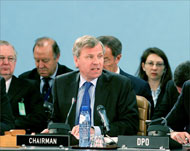Nato split on Afghan operation
Nato chiefs are trying to overcome disagreements over the alliance’s future in Afghanistan, including plans for it to take overall command of security operations from the US-led coalition there.

Four days before key Afghan parliamentary elections, US Defence Secretary Donald Rumsfeld spoke of possible reductions in US troops and told Nato allies at a meeting in Berlin it was time they helped fight the insurgency.
Britain backs Rumsfeld’s call for the Nato-led ISAF force to get tougher on the ground.
But other European allies, including Germany and France, have resisted a plan that would see ISAF in charge of both peacekeeping and counter-insurgency.
“It isn’t something that will happen overnight and without discussion,” said British Defence Secretary John Reid on Wednesday.
“People come to this with different primary purposes and different histories … . There is a will to get there, but the world is not black and white,” he told a news briefing.
Danger zones
Nato has some 10,000 peacekeepers in the capital, Kabul, the north and the western part of Afghanistan.
 |
|
Afghans go to the polls on Sunday |
Assuming elections on Sunday pass off smoothly, Nato wants to extend its reach into the more dangerous south and east through next year.
But German Defence Minister Peter Struck said ISAF must remain distinct from the US-coalition of roughly 20,000 troops which bears the brunt of the fight with Taliban-led fighters.
“I would not like to expose our soldiers to more danger by linking these two mandates together,” he told German radio.
The coalition has been fighting in Afghanistan since the 2001 US-led invasion to oust its Taliban rulers. Nato took charge of the UN-mandated ISAF stabilisation mission two years later.
The US, whose army is badly stretched by the war in Iraq, has dropped an earlier call for Nato to swallow up coalition.
Compromise
Instead it backs a compromise put forward by Nato Secretary-General Jaap de Hoop Scheffer for a “dual-headed” structure under which the two missions remain separate but report higher up to a single, Nato command.
But France is yet to be convinced.
 |
|
Nato’s Jaap de Hoop Scheffer (C) |
“These are two missions; they are completely different,” French Defence Minister Michele Alliot-Marie said.
“The forces should remain distinct, and their command too,” she told a news briefing.
Britain is due to lead Nato’s expansion of its peacekeeping duties into the south early next year, a move which could lead to several thousand more Nato troops in Afghanistan.
Troop reduction
The New York Times newspaper reported that unnamed senior Pentagon and military officials were discussing a proposal to cut American troop levels at the same time by as much as 4000.
|
“As the situation improves in Afghanistan, one would think that all foreign forces could be reduced over time” Donald Rumsfeld |
Rumsfeld would not be drawn on numbers but conceded that a greater Nato presence could allow US cuts – something that would be viewed nervously by Afghan authorities.
“It depends on what’s happening on the ground,” Rumsfeld said.
Rumsfeld noted the growing number of Nato troops in Afghanistan and mentioned the importance of the continued growth of Afghan security forces in size and capability.
“As the situation improves in Afghanistan, one would think that all foreign forces could be reduced over time,” he said.